GATE 2021 BT Question Paper with Answer Key is available for the GATE students. The overall difficulty level of GATE 2021 AR was rated moderate. Overall difficulty level of those sections dedicated to Biotechnology was moderate to difficult. Sections related to Biotechnology carried almost 70% in GATE 2021 BT. The rest of the 30% were distributed across Aptitude and Engineering Mathematics. The question paper was a combination of MCQs (Multiple Choice Questions), MSQs (Multiple Select Questions) and NAT (Numerical Answer Type).
Candidates aiming for GATE are highly suggested to download previous year GATE Question Papers and Answer Keys to keep an eye on the preparation level.
GATE 2021 BT Question Paper with Answer Key - Forenoon Session
| GATE 2021 BT Question Paper | GATE 2021 BT Answer Key | GATE 2021 BT Solutions |
|---|---|---|
| Download PDF | Download PDF | Download PDF |
GATE 2021 BT Solutions
| S No. | Question | Correct Option | Explanation |
|---|---|---|---|
| 1 | The ratio of boys to girls in a class is 7 to 3. Acceptable value for the total number of students is: (A) 21 (B) 37 (C) 50 (D) 73 | (C) 50 | (C) 50, The ratio of boys to girls in a class is 7 to 3. So, the total number of students must be a multiple of 7+3 = 10. Among the given options, only 50 is a multiple of 10. Therefore, the acceptable value for the total number of students in the class is 50. So, the answer is (C). |
| 2 | Consider the sentences: (i) Everybody in the class is prepared for the exam. (ii) Babu invited Danish because he enjoys chess. The observation is: (A) (i) is correct, (ii) unambiguous (B) (i) incorrect, (ii) unambiguous (C) (i) correct, (ii) ambiguous (D) (i) incorrect, (ii) ambiguous | (C) (i) correct, (ii) ambiguous | Sentence (i): "Everybody in the class is prepared for the exam" is grammatically correct. The subject "Everybody" takes a singular verb, "is". Sentence (ii): "Babu invited Danish to his home because he enjoys playing chess" is ambiguous. It remains ambiguous which "he" refers toBabu or Danish. This ambiguity makes the sentence ambiguous |
| 3 | Biotechnology (BT) is to surgery as writer is to: (A) Plan, outline (B) Hospital, library (C) Doctor, book (D) Medicine, grammar | (B) Hospital, library | The analogy compares fields or professions to the places or contexts they are most associated with."Biotechnology (BT) is to surgery" compares a field of study to its practical application.Similarly, "writer is to library" compares a profession to a place associated with writing.It follows the same logical relationship, both examples matching a profession or field to a space that holds an association with it. |
| 4 | Probability that at least two chocolates are identical from five bags each containing 10 distinct chocolates: (A) 0.3024 (B) 0.4235 (C) 0.6976 (D) 0.8125 | (C) 0.6976 | The total ways to pick chocolates is 10^5. The probability of no chocolates being identical is ~0.3024, so the probability that at least two are identical is ~0.6976. |
| 5 | Statements: 1) All bacteria are microorganisms. 2) All pathogens are microorganisms. Conclusion I: Some pathogens are bacteria. Conclusion II: All pathogens are not bacteria. Correct option is: (A) Only I (B) Only II (C) Either I or II (D) Neither I nor II | (B) Only II | Conclusion I is incorrect as the statements don't link pathogens with bacteria. Conclusion II is correct because not all pathogens are bacteria; some could be viruses or fungi. |
| 6 | Anti-obesity measures like displaying calorie information sidestep the core issues like poverty. The statement that summarizes the passage is: (A) AOM addresses core issues. (B) Obesity causes poverty. (C) AOM addresses the issues well. (D) AOM addresses the issue superficially. | (D) AOM addresses the issue superficially. | The same passage points out that antiobesity measures (AOM), including nonsensical tactics like posting calorie information, fail to address the actual obesity determinants: poverty and income inequality. These measures are but only symptomatic, hence do not address the root of the problem. Thus, it is correct to state that AOM are solving the problem on the surface. |
| 7 | Coronavirus genome consists of: (A) Double-stranded DNA (B) Double-stranded RNA (C) Negative-sense single-stranded RNA (D) Positive-sense single-stranded RNA | (D) Positive-sense single-stranded RNA | SARSCoV2 and other coronaviruses are armed with light positive strand single stranded RNA genome. This means that once inside a host cell their RNA acts as mRNA for synthesizing proteins, which makes it easy for a virus to replicate. The other choices such as the doublestranded DNA, or RNA, do not describe the genome in coronaviruses. |
| 8 | The enzyme that transcribes eukaryotic genes encoding precursor ribosomal RNAs (28S, 18S, 5.8S rRNAs) is: (A) RNA polymerase I (B) RNA polymerase II (C) RNA polymerase III (D) RNA polymerase IV | (A) RNA polymerase I | In eukaryotic cells synthesis of the precursor ribosomal RNAs (prerRNAs), such as 28S, 18S and 5.8S rRNA is by RNA polymerase I. These rRNAs are involved in structure and function of the ribosome that is involved in protein synthesis. RNA polymerase II synthesizes mRNA, RNA polymerase III synthesizes tRNA and 5S rRNA thus RNA polymerase I is solely responsible for the synthesis of rRNA. |
| 9 | The number of unrooted trees in a phylogeny of five sequences is: (A) 3 (B) 15 (C) 105 (D) 945 | (C) 105 | The number of unrooted trees is calculated using the formula (2n - 3)! / (2^(n-2) (n-2)!), where n is the number of sequences. For 5 sequences, it results in 105 unrooted trees. |
| 10 | The method used to test the significance of a predicted phylogeny is: (A) Bootstrap (B) Maximum likelihood (C) Maximum parsimony (D) Minimum evolution | (A) Bootstrap | The bootstrap method is widely utilised as a means for investigating the reliability and significance of a given phylogeny prediction. It comprises repetition of the data and then making new samples and then formulating phylogenies from these samples. The number of trees in which a specific branch occurs determines the level of support in this case, statistical. Concerning that, the bootstrap method cannot be used for building trees, although maximum likelihood and maximum parsimony methods can, while the bootstrap is applied to the trees’ phylogeny impeachment. |
| 11 | The Cartesian coordinates (x, y) of a point A with polar coordinates (4, 7/4) are: (A) (√3, 2√2) (B) (2, 2√3) (C) (2√2, √3) (D) (2√2, 2√2) | (D) (2√2, 2√2) | Using the formulas for converting polar to Cartesian coordinates, x = r cos(θ) and y = r sin(θ), with r = 4 and θ = 7/4, we get (2√2, 2√2). |
| 12 | Incorrect statement about hybridoma production: (A) Hybridoma cells can use hypoxanthine and thymidine (B) DNA synthesis in myeloma cells is blocked by aminopterin (C) Hybridoma cells produce polyclonal antibodies (D) Polyethylene glycol fuses myeloma cells to B-cells | (C) Hybridoma cells produce polyclonal antibodies | Hybridoma cells are specifically designed to produce monoclonal antibodies, not polyclonal antibodies. Monoclonal antibodies are derived from a single Bcell clone and target one specific epitope. |
| 13 | Which technique is NOT used for inserting a foreign gene into a cell: (A) DNA microarray (B) Electroporation (C) Gene gun (D) Microinjection | (A) DNA microarray | :DNA microarray is a technique that is employed for gene expression profiling and in identification of specific DNA sequences but it is not applied to introduce foreign genes into cells. |
| 14 | CRISPR-Cas system is associated with: (A) Adaptive immunity in eukaryotes (B) Adaptive immunity in prokaryotes (C) Innate immunity in eukaryotes (D) Innate immunity in prokaryotes | (B) Adaptive immunity in prokaryotes | The CRISPRCas system is a defense mechanism found in prokaryotes (bacteria and archaea) that provides adaptive immunity. It works by capturing snippets of viral DNA and incorporating them into the bacteria's genome. If the virus attacks again, the system recognizes and cuts the viral DNA, preventing infection. This process is adaptive because it "remembers" past invaders, similar to adaptive immunity in higher organisms. |
| 15 | The process by which intracellular macromolecules are supplied for lysosomal degradation during nutrient starvation is: (A) Apoptosis (B) Autophagy (C) Phagocytosis (D) Pinocytosis | (B) Autophagy | Selfconsumption is the process in which damaged cell components and intracellular macromolecules that are under nutrient stress are taken to lysosomes for degradation. To balance energy the cell is capable of degrading some of its components in order to recycle nutrients. When the conditions which can cause nutrient starvation exist it helps in protecting the survival of the cell. |
| 16 | The enzyme that adds phosphate group to the free 5' terminus of a DNA sequence is: (A) Adenosine kinase (B) Alkaline phosphatase (C) Polynucleotide kinase (D) Terminal deoxynucleotidyl transferase | (C) Polynucleotide kinase | Polynucleotide kinase (PNK) adds phosphate groups to the 5' end of DNA or RNA, which is critical for ligation during DNA repair processes. |
| 17 | Which one of the following is correct about microbial growth medium? (A) Luria-Bertani broth is synthetic (B) Nutrient broth is defined (C) Sabouraud dextrose agar is differential (D) Trypticase soy agar is complex | (D) Trypticase soy agar is complex | Trypticase soy agar (TSA) is a complex medium that provides a nutrient-rich environment for diverse microbial growth. |
| 18 | The process which utilizes the RNA-induced silencing complex (RISC) to block gene expression is: (A) RNA editing (B) RNA interference (C) RNA polyadenylation (D) RNA splicing | (B) RNA interference | RNA interference (RNAi) uses the RISC complex to degrade or inhibit the translation of specific mRNA molecules, effectively silencing gene expression. |
| 19 | Which layer(s) is/are formed from the inner cell mass of the blastocyst? (A) Ectoderm (B) Endoderm (C) Mesoderm (D) Trophectoderm | (A), (B), (C) | The inner cell mass of the blastocyst develops into three primary germ layers: ectoderm, endoderm, and mesoderm. Trophectoderm forms the placenta. |
| 20 | Which cell organelle(s) is/are surrounded by a single phospholipid membrane? (A) Golgi apparatus (B) Lysosome (C) Mitochondria (D) Nucleus | (B) Lysosome | Lysosomes are surrounded by a single phospholipid membrane, whereas mitochondria and the nucleus are double-membraned organelles. |
| 21 | Match enzymes in Group I with their corresponding industrial application in Group II: (P) Amylase (1) Laundry detergent (Q) Invertase (2) Fruit juice clarification (R) Pectinase (3) Liquefaction of sucrose (S) Xylanase (4) Pulp and paper processing | (B) P1, Q3, R2, S4 | Amylase is used in laundry detergent, invertase in sucrose liquefaction, pectinase in fruit juice clarification, and xylanase in pulp and paper processing. |
| 22 | Match separation methods in Group I with associated properties in Group II: (P) Centrifugation (1) Density (Q) Dialysis (3) Size (R) Solvent extraction (2) Solubility (S) Ultrafiltration (4) Diffusivity | (C) P1, Q3, R2, S4 | Centrifugation separates by density, dialysis by size, solvent extraction by solubility, and ultrafiltration by diffusivity. |
| 23 | Match autoimmune diseases in Group I with the corresponding primarily affected organ in Group II: (P) Hashimoto's disease (1) Brain (Q) Juvenile diabetes (2) Pancreas (R) Multiple sclerosis (3) Skeletal muscle (S) Myasthenia gravis (4) Thyroid | (C) P4, Q2, R1, S3 | Hashimoto's disease affects the thyroid, juvenile diabetes affects the pancreas, multiple sclerosis affects the brain, and myasthenia gravis affects skeletal muscles. |
| 24 | Match hypersensitivity types in Group I with their corresponding condition in Group II: (P) Type I (2) Host reaction to bee venom (Q) Type II (1) Erythroblastosis fetalis (R) Type III (3) Systemic lupus erythematosus (S) Type IV (4) Tuberculin reaction | (A) P2, Q3, R1, S4 | Type I is an immediate reaction like to bee venom, Type II involves erythroblastosis fetalis, Type III is related to systemic lupus erythematosus, and Type IV is delayed, like the tuberculin reaction. |
| 25 | Which combinations of plant hormones and their associated functions are correct? (P) Abscisic acid - Breaks seed dormancy (Q) Auxin - Induces cell division (R) Ethylene - Stimulates ripening of fruits (S) Gibberellin - Promotes seed dormancy | (A) P and R only | Abscisic acid promotes seed dormancy, not breaking it. Auxin promotes cell elongation, not division. Ethylene stimulates fruit ripening. Gibberellin breaks seed dormancy. |
| 26 | Which tool is used to compare all possible six open reading frames of a nucleotide query sequence with available six open reading frames in the database? (A) BLASTN (B) BLASTX (C) TBLASTN (D) TBLASTX | (B) BLASTX | BLASTX compares six reading frames from a nucleotide query sequence with protein databases to find protein-coding regions. |
| 27 | In Neurospora crassa, a mutation in the poky gene results in slow growth. The results of four crosses are given. Which one explains the inheritance mode of poky? (A) Episomal inheritance (B) Mendelian inheritance (C) Mitochondrial inheritance (D) X-linked inheritance | (C) Mitochondrial inheritance | The poky phenotype follows maternal inheritance, typical of mitochondrial genes, as all progeny from a poky mother are poky. |
| 28 | Tertiary structure of a protein consisting of α-helices and β-strands can be determined by: (A) Circular dichroism spectroscopy (B) Mass spectrometry (C) Nuclear magnetic resonance spectroscopy (D) UV spectroscopy | (C) Nuclear magnetic resonance spectroscopy | NMR spectroscopy can determine the 3D structure of proteins, particularly those with α-helices and β-strands, in solution. |
| 29 | Which of the following is correct about Agrobacterium tumefaciens? (A) Contains tumor-inducing plasmid (B) Causes crown gall disease in dicots (C) Is a Gram-positive bacterium (D) Used for generating transgenic plants | (A), (B), (D) | Agrobacterium tumefaciens is a Gram-negative bacterium that carries a tumor-inducing plasmid, causes crown gall disease, and is used in plant genetic engineering. |
| 30 | Which of the following antimicrobial agents is a growth factor analog? (A) 5-Fluorouracil (B) Isoniazid (C) Sulfanilamide (D) Tetracycline | (C) Sulfanilamide | Sulfanilamide mimics para-aminobenzoic acid (PABA) and inhibits bacterial folic acid synthesis, making it a growth factor analog. |
| 31 | Which chemical messenger(s) is/are derivatives of tryptophan? (A) γ-Amino butyric acid (B) Indole acetic acid (C) Melatonin (D) Serotonin | (C), (D) | Both melatonin and serotonin are derived from tryptophan. Melatonin is synthesized from serotonin, which itself is derived from tryptophan. |
| 32 | The enzyme telomerase synthesizes: (A) Telomeric DNA at the 5’ end of the chromosomes (B) Telomeric DNA at the 3’ end of the chromosomes (C) RNA at the 5’ end of the chromosomes (D) RNA at the 3’ end of the chromosomes | (B) Telomeric DNA at the 3’ end of the chromosomes | Telomerase adds repetitive DNA sequences to the 3’ end of chromosomes to maintain telomere length. |
| 33 | Which one of the following methods is commonly used to study protein-protein interactions? (A) Western blotting (B) ELISA (C) Yeast two-hybrid system (D) Polymerase chain reaction (PCR) | (C) Yeast two-hybrid system | The yeast two-hybrid system is a molecular biology technique used to study protein-protein interactions. |
| 34 | Which of the following cell types is most abundant in the human blood? (A) Lymphocytes (B) Neutrophils (C) Red blood cells (D) Platelets | (C) Red blood cells | Red blood cells (erythrocytes) are the most abundant cell type in human blood, responsible for oxygen transport. |



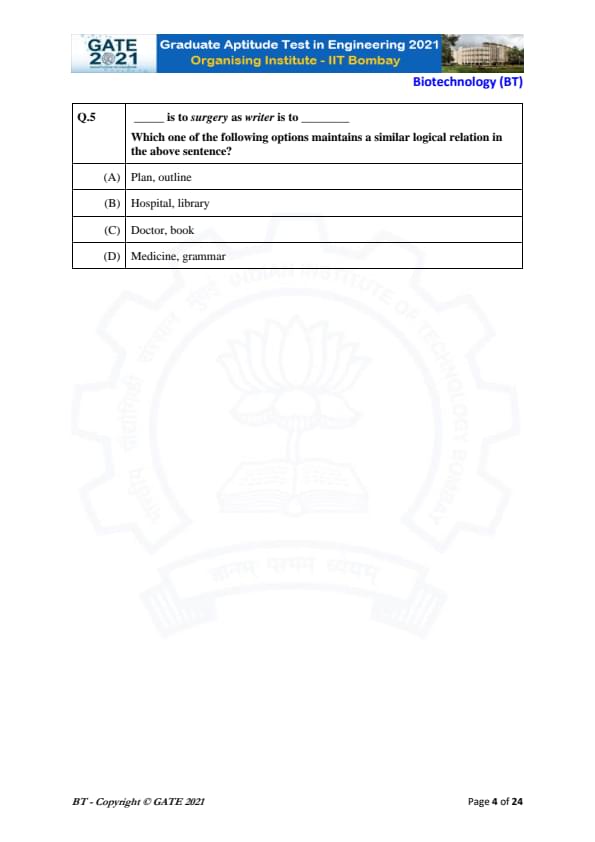
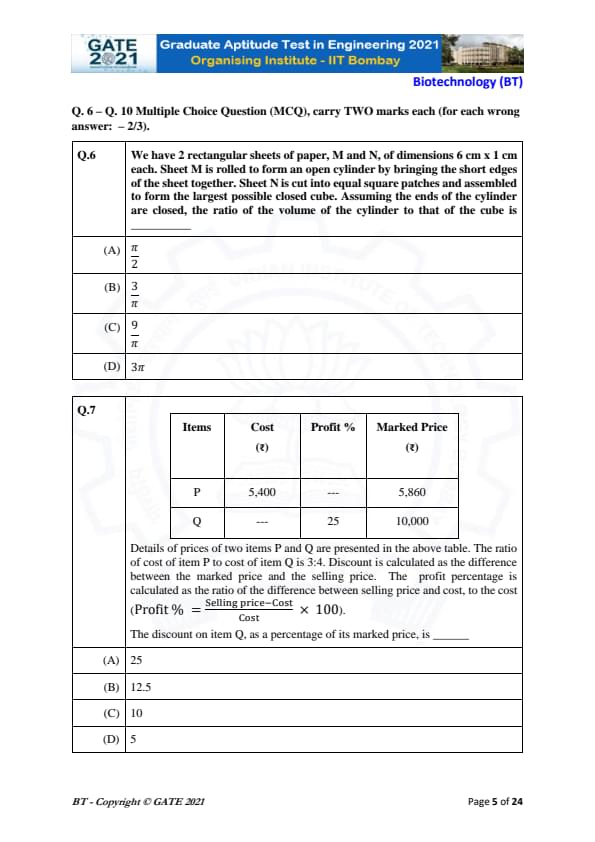

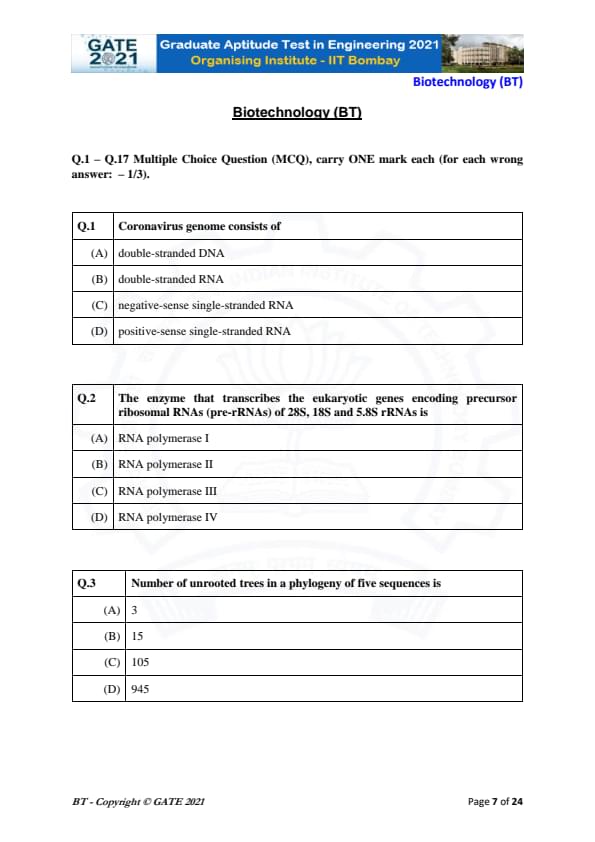

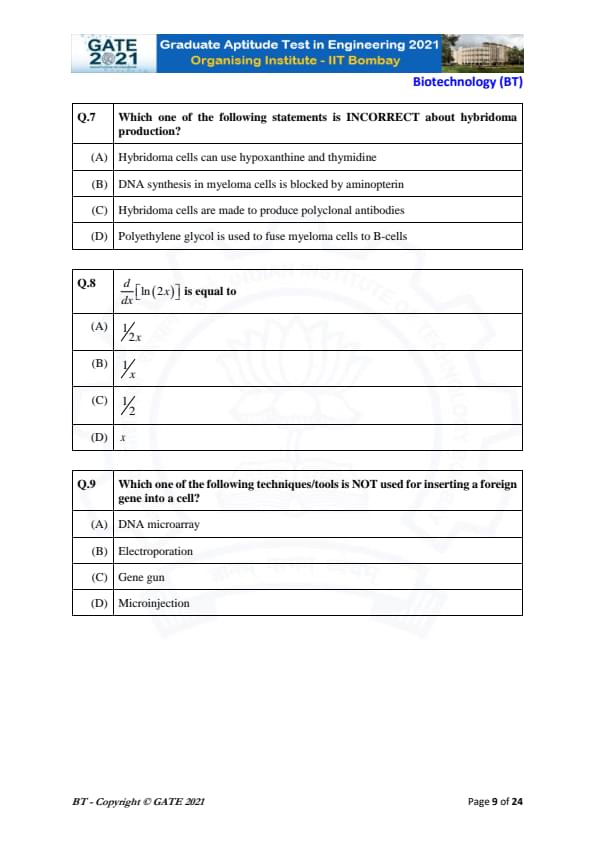
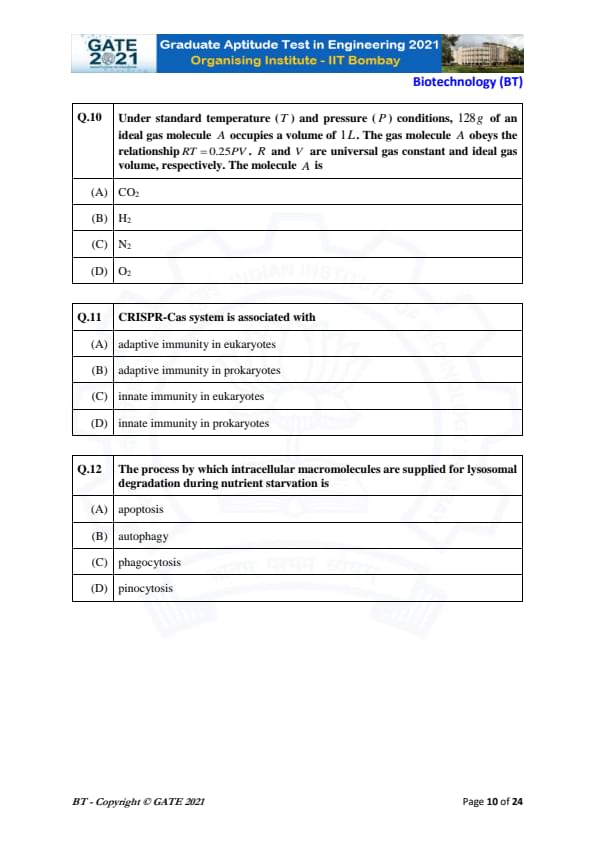
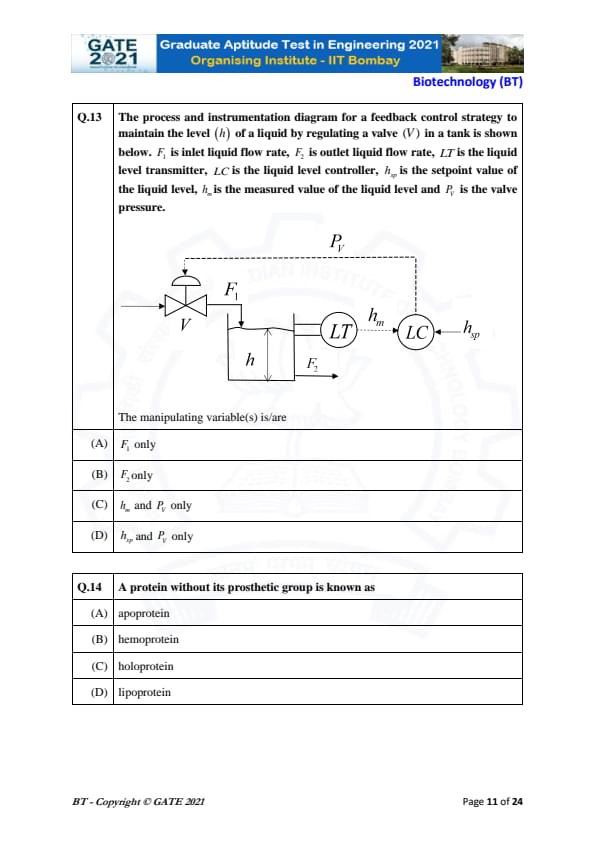


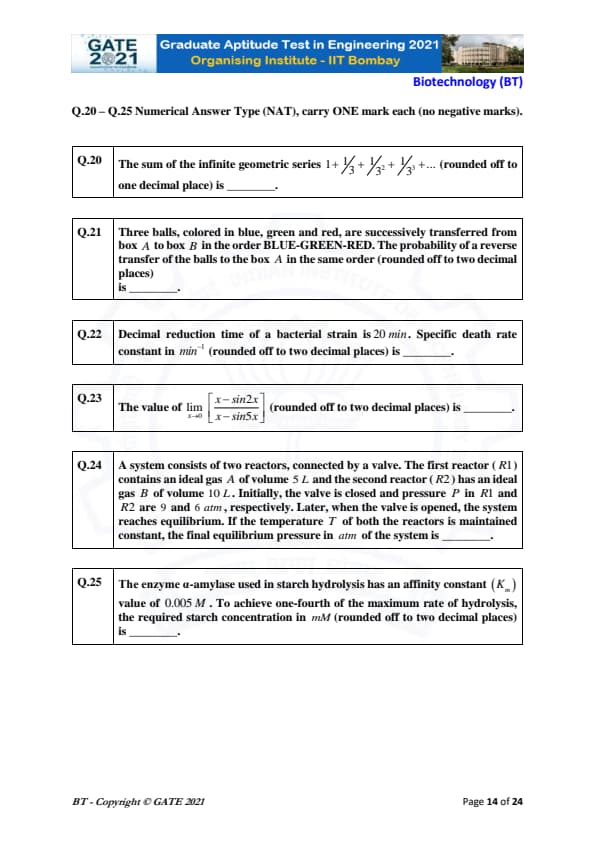
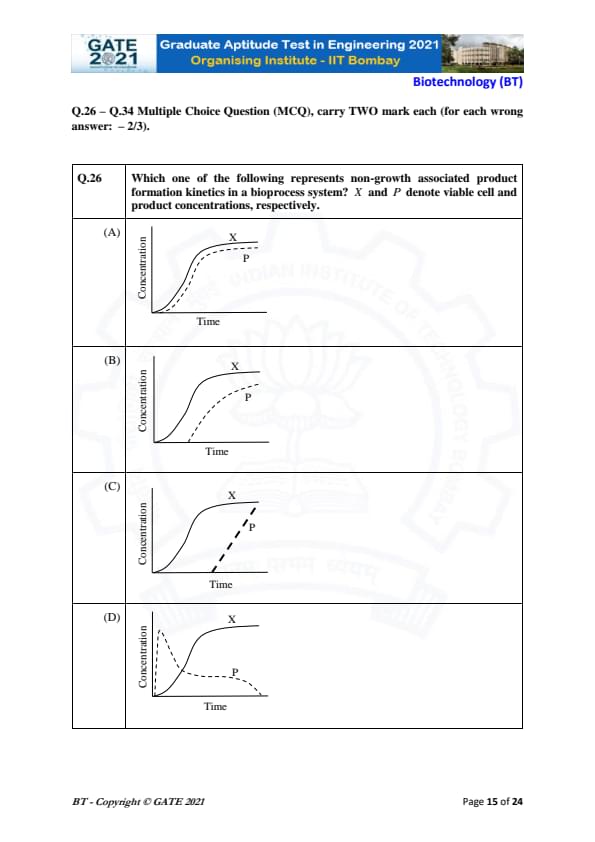

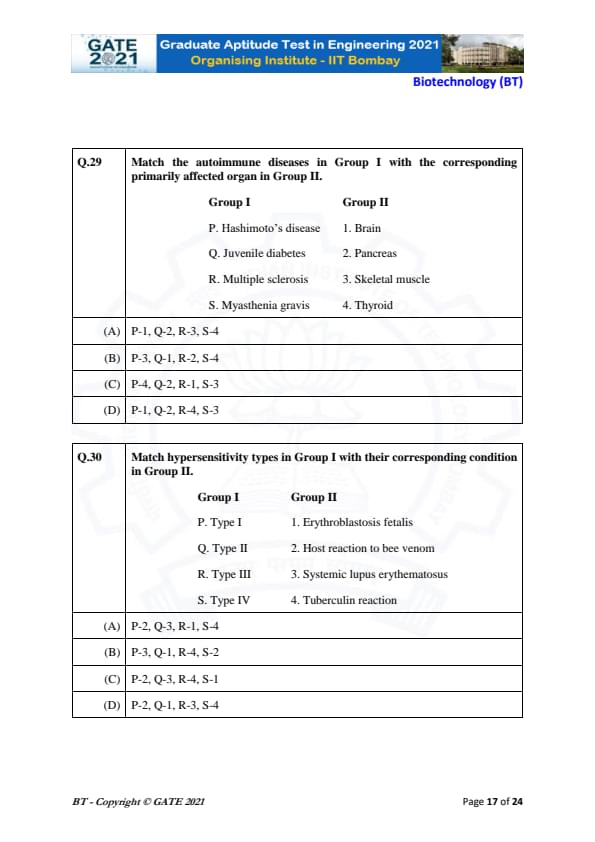


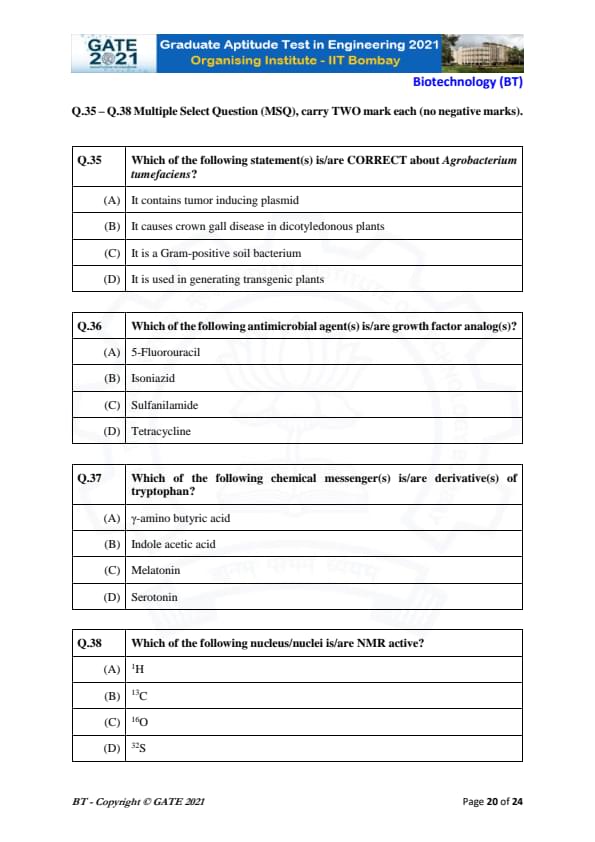
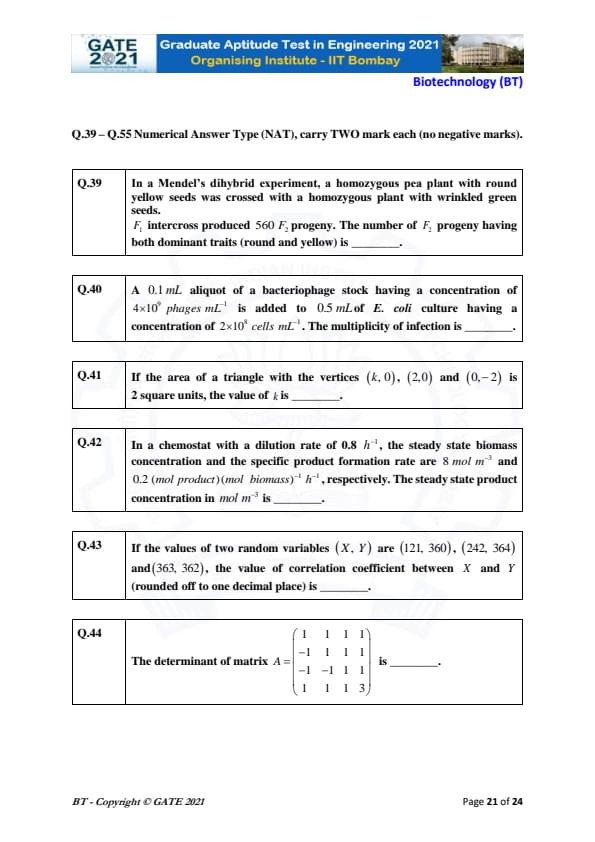

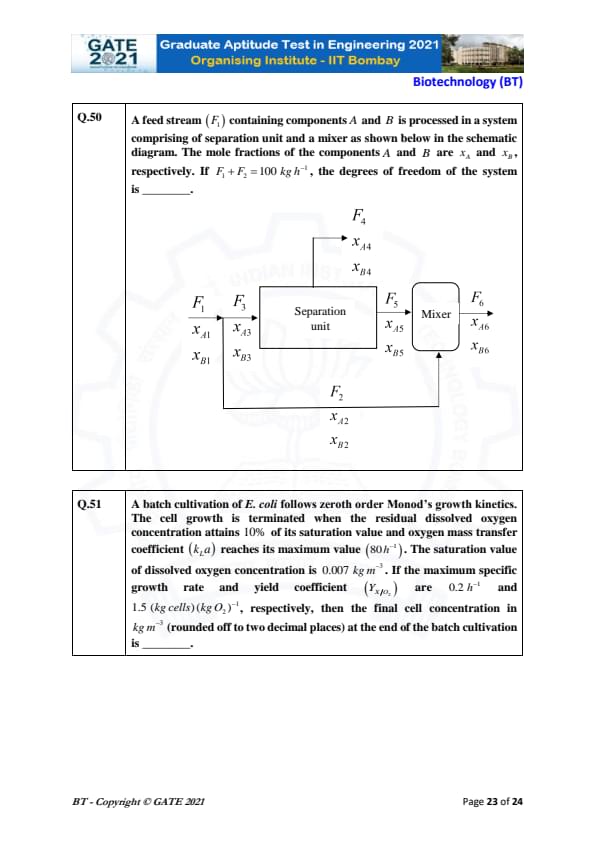

Quick Links:
GATE 2021 BT Paper Analysis
Following the previous year GATE pattern, IIT Bombay listed 65 questions, carried 100 marks. Both easy, moderate, and difficult level questions were asked in GATE 2021 BT.
Please refer to the below-mentioned table to get a detailed analysis of the question pattern of GATE 2021 BT-
| Type of Questions | No. Of Questions | Carried Marks |
|---|---|---|
| No. Of 1 mark MCQs | 22 | 22 |
| No. Of 2 marks MCQs | 14 | 28 |
| No. Of 1 mark MSQ | 2 | 2 |
| No. Of 2 marks MSQs | 4 | 8 |
| No. Of 1 mark NATs | 6 | 6 |
| No. Of 2 marks NATs | 17 | 34 |
- In GATE 2021 BT, a significant number of questions were asked from the NAT section
- Exactly 40% of the total weightage was carried by NAT questions that were distributed across six 1 mark NATs and 17 questions holding 2 marks each question
- The number of MSQs was low, only 6 questions appeared from the NAT section that contributed 10% of the total weightage
- MCQs dominated the question paper of GATE 2021 BT, by holding 50% weightage.
| Subjects | GATE BT 2021- Weightage of Topics | |
|---|---|---|
| 1M | 2M | |
| Engineering Mathematics | 5 | 5 |
| Biochemistry | 2 | 1 |
| Microbiology | 2 | 2 |
| Cell Biology | 1 | 1 |
| Molecular Biology & Genetics | 6 | 2 |
| Analytical Techniques | 1 | 3 |
| Immunology | 1 | 2 |
| Bioinformatics | 1 | 1 |
| Recombinant Dna Technology | 1 | 1 |
| Plant Biotechnology | 1 | 3 |
| Animal Biotechnology | 3 | - |
| Bioprocess Engineering & Process Biotechnolgy | 3 | 12 |
Also Check:
This year, students faced a new type of question, MSQs that comes with one or more than one correct answers. A candidate has to choose all the correct answers in order to get the marks.
- Wrong MCQs would result in deduction of ⅓ marks and ⅔ marks for each incorrect answer respectively
- MSQs and NTAs are not in the list of negative marking scheme
- The cutoff goes up to 30 for General, 27 for OBSs, and 20 for SC/ST
- A student must attempt 40-43 questions to clear the cutoff
GATE Previous Year Question Papers:
| GATE 2022 Question Papers | GATE 2021 Question Papers | GATE 2020 Question Papers |
| GATE 2019 Question Papers | GATE 2018 Question Papers | GATE 2017 Question Papers |



Comments